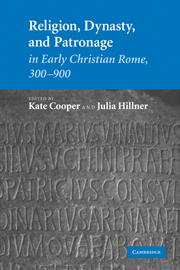Book contents
- Frontmatter
- Contents
- Acknowledgements
- List of contributors
- Abbreviations
- Introduction
- PART I ICONS OF AUTHORITY: POPE AND EMPEROR
- PART II LAY, CLERICAL, AND ASCETIC CONTEXTS FOR THE ROMAN GESTA MARTYRUM
- 3 Domestic conversions: households and bishops in the late antique ‘papal legends’
- 4 Agnes and Constantia: domesticity and cult patronage in the Passion of Agnes
- 5 ‘A church in the house of the saints’: property and power in the Passion of John and Paul
- PART III RELIGION, DYNASTY, AND PATRONAGE
- Bibliography
- Index
4 - Agnes and Constantia: domesticity and cult patronage in the Passion of Agnes
Published online by Cambridge University Press: 02 October 2009
- Frontmatter
- Contents
- Acknowledgements
- List of contributors
- Abbreviations
- Introduction
- PART I ICONS OF AUTHORITY: POPE AND EMPEROR
- PART II LAY, CLERICAL, AND ASCETIC CONTEXTS FOR THE ROMAN GESTA MARTYRUM
- 3 Domestic conversions: households and bishops in the late antique ‘papal legends’
- 4 Agnes and Constantia: domesticity and cult patronage in the Passion of Agnes
- 5 ‘A church in the house of the saints’: property and power in the Passion of John and Paul
- PART III RELIGION, DYNASTY, AND PATRONAGE
- Bibliography
- Index
Summary
Let us celebrate the feast day of the most holy Virgin. Here, let psalms echo, there, let sermons resound. Here, let a throng of people rejoice, while there let the poor of Christ be washed … At thirteen years old she overcame death, and came into life, since she esteemed only the Creator of life. She was counted as a child in years, but there was boundless wisdom in her mind: young in her body, but wise in her soul; beautiful in appearance, yet more beautiful in faith.
The martyrdom of the Roman virgin Agnes was a sight to behold, according to an impressive group of late Roman narrators, including Bishop Ambrose of Milan, Prudentius, and the anonymous author of the Passio Agnetis (BHL 156), quoted here. To a greater or lesser degree, these authors revel in conjuring the scene, dwelling on the beauty of the young woman (she is nearly ravished by her persecutors in a brothel), her eagerness to feel the thrust of the executioner's sword, and the intensity of her desire to be joined to Christ. The sexual element in her persecution and death in these narratives has made of Agnes something of a spectacle in modern scholarship, an iconic figure in analyses of the erotics of male ascetic Christianity. It may be, however, that we are the victims of our own interest in contemporary voyeurism.
- Type
- Chapter
- Information
- Publisher: Cambridge University PressPrint publication year: 2007
- 4
- Cited by



